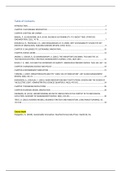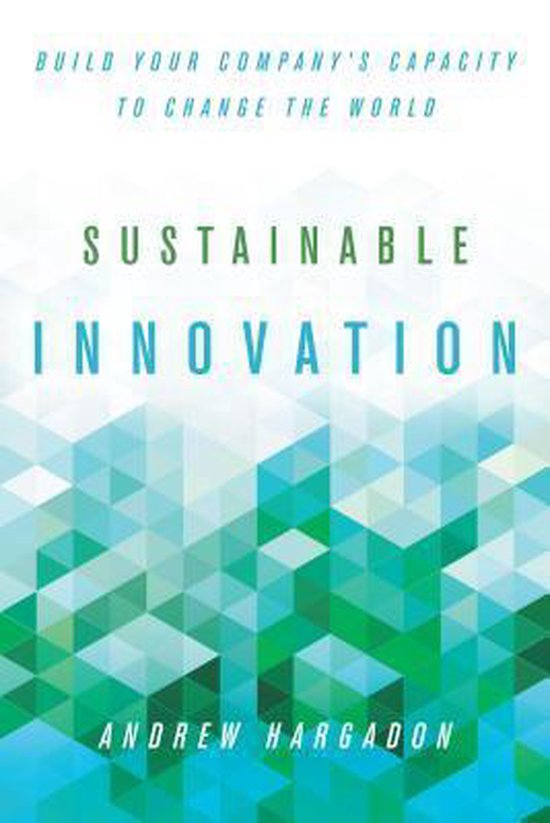Table of Contents
INTRODUCTION....................................................................................................................................................... 2
CHAPTER 1 SUSTAINABLE INNOVATION ................................................................................................................. 3
CHAPTER 2 BETTING ON CHANGE .......................................................................................................................... 5
BANSAL, P., & DESJARDINE, M.R. (2014). BUSINESS SUSTAINABILITY: IT IS ABOUT TIME. STRATEGIC
ORGANIZATION, 12(1), 70-78. ................................................................................................................................ 7
NIDUMOLU, R., PRAHALAD, C.K., AND RANGASWAMI, M. R. (2009). WHY SUSTAINABILITY IS NOW THE KEY
DRIVER OF INNOVATION, HARVARD BUSINESS REVIEW. 87(9): 56-64 ................................................................... 9
CHAPTER 3 CHALLENGES TO SUSTAINABLE INNOVATION .................................................................................... 10
CHAPTER 4 NEXUS WORK ..................................................................................................................................... 13
ANSARI, S., GARUD, R., & KUMARASWAMY, A. (2016). THE DISRUPTOR'S DILEMMA: TIVO AND THE US
TELEVISION ECOSYSTEM. STRATEGIC MANAGEMENT JOURNAL, 37(9), 1829-1853 ............................................ 15
DAVID, P. A. 1985. CLIO AND THE ECONOMICS OF QWERTY. AMERICAN ECONOMIC REVIEW. 75(2) 332–337. . 18
CHAPTER 5 MANAGING SCIENCE AND POLICY ..................................................................................................... 19
CHAPTER 6 RECOMBINANT INNOVATION ............................................................................................................ 21
FLEMING, L. (2007). BREAKTHROUGHS AND THE “LONG TAIL OF INNOVATION”. MIT SLOAN MANAGEMENT
REVIEW, 49(1), 69–74. .......................................................................................................................................... 23
HARGADON, A., DOUGLAS, Y. (2001). WHEN INNOVATIONS MEET INSTITUTIONS: EDISON AND THE DESIGN OF
THE ELECTRIC LIGHT. ADMINISTRATIVE SCIENCES QUARTERLY, 46(3), 476-501. ................................................. 24
CHAPTER 7 DESIGNING REVOLUTIONS ................................................................................................................. 26
CHAPTER 8 BUSINESS MODEL INNOVATION ........................................................................................................ 28
EISENMAN, M. (2013). UNDERSTANDING AESTHETIC INNOVATION IN THE CONTEXT OF TECHNOLOGICAL
EVOLUTION. ACADEMY OF MANAGEMENT REVIEW, 38(3), 332-351................................................................... 30
TEECE, D. (2010). BUSINESS MODELS, BUSINESS STRATEGY AND INNOVATION. LONG RANGE PLANNING, 43,
172-194. ................................................................................................................................................................ 33
Course book
Hargadon, A. (2015). Sustainable Innovation. Stanford University Press: Stanford, CA.
,Introduction
Sustainable innovation means two things:
- Generating, developing, and launching new products and processes that “meet the needs of
the present without compromising the ability of future generations to meet their own
needs”.
- Because a single innovation will neither support an organization nor drive fundamental
change across an industry, it is also about building an organization capable of sustaining the
pace of innovation over a decade or more.
Sometimes sustainability looks like:
- Shifting market preferences: high-mileage cars, energy efficient appliances, wholesome
foods, organic cotton.
- Competing technologies: rooftop solar, hybrid cars, biopesticides, LED bulbs.
- Changing policies: mileage standards, Energy Star rating, carbon cap-and-trade programs,
increase in the minimum wage
Three obstacles stand in the way of setting bold new strategies:
1. When facing the uncertainties associated with sustainability, most companies avoid taking
action, preferring to wait for something to happen that will reduce the uncertainties for
them.
2. When companies are moved to action, it most often means copying what other are doing.
Organizational researchers call this “mimesis”, and it means, essentially, seeking safety in the
herd.
3. Companies develop a new line of green products that compete with their existing offerings,
confuse their customers, burden their suppliers, and strain the knowledge of their sales reps.
2
,Chapter 1 Sustainable Innovation
Sustainable innovation is
the development of new
products or processes that
consume fewer
environmental resources,
foster the health of
individuals and
communities, and are
financially viable for
producers and consumers
alike. It is also about
creating organizations
capable of innovating time
and again at a pace they
can sustain.
Information technology
enables sustainable
innovations.
The last decade brought a surging consensus on the realities of climate change and related
challenges. This has led to a growing awareness of how a changing environment can and will affect
us. Firms are now feeling the direct effects: disruption in supply chains and operations caused by
remote flooding or drought, repercussions from use of toxic materials or equally toxic labour
practices by suppliers, the rising costs of insurance and capital, rapidly shifting customer preferences
that are the result of growing awareness, shifting demographics, and the radical transparency of the
Internet age.
The science of the effects of unsustainable practices includes our understanding of climate change,
ability to track greenhouse gas emissions and measure their impact, and understanding of
agriculture, tuition, water use and so many other aspects of modern society. For corporate leaders, it
includes accepted theories and standards for modelling and measuring the impacts and risks
associated with sustainability.
Technologies have emerged and evolved. The economics of clean energy technologies have
improved to the point of competing evenly with traditional energy sources.
What customers value influences what problems are solved by new combinations of these technical
possibilities. They define what markets want and are willing to pay for. On the other hand, market
preferences are also redefining what will no longer be tolerated. This social contract reflects public
opinion about what companies should and should not be allowed to do.
The challenge for any leader is to build an organization able to thrive, or at least survive, when
change hits its markets, and that means ensuring it has the right capabilities for innovation
- There is no shortage of role models
- Other than the crowd favourites, there is barely any overlap between the lists.
3
, The best practices that correlate most strongly with generating, developing and delivering successful
innovations are: cross-functional product development teams, heavyweight team leaders, boundary-
scanning activities, prototyping and a tolerance for risk.
Capability: a strength, a skill, competitive advantage of an organization.
In relative stable times, you need the right capabilities to compete effectively, but when conditions
are changing, you also need the right capabilities to innovate effectively à Dynamic capabilities to
take advantage of opportunities, respond appropriately to threats, and maintain your competitive
advantage amid shifting tides.
The biggest challenges within innovation are not in coming up with new ideas but rather in
recognizing the convergence of technologies, market trends and regulatory shifts taking place, in
connecting and developing those ideas into functioning innovations, and in delivering them to the
market at the right time and at the right scale.
Commitment represents more than a single decision, it is itself a capability embedded in and
supported by your company’s people, structure, culture and reward system. That commitment
enables an innovation strategy.
Three lessons
1. An idea is nothing without the right capabilities to bring to the market
2. Where you want to go dictates what you need to get there
3. There is a common set of challenges and capabilities in the pursuit of sustainable innovation.
4






